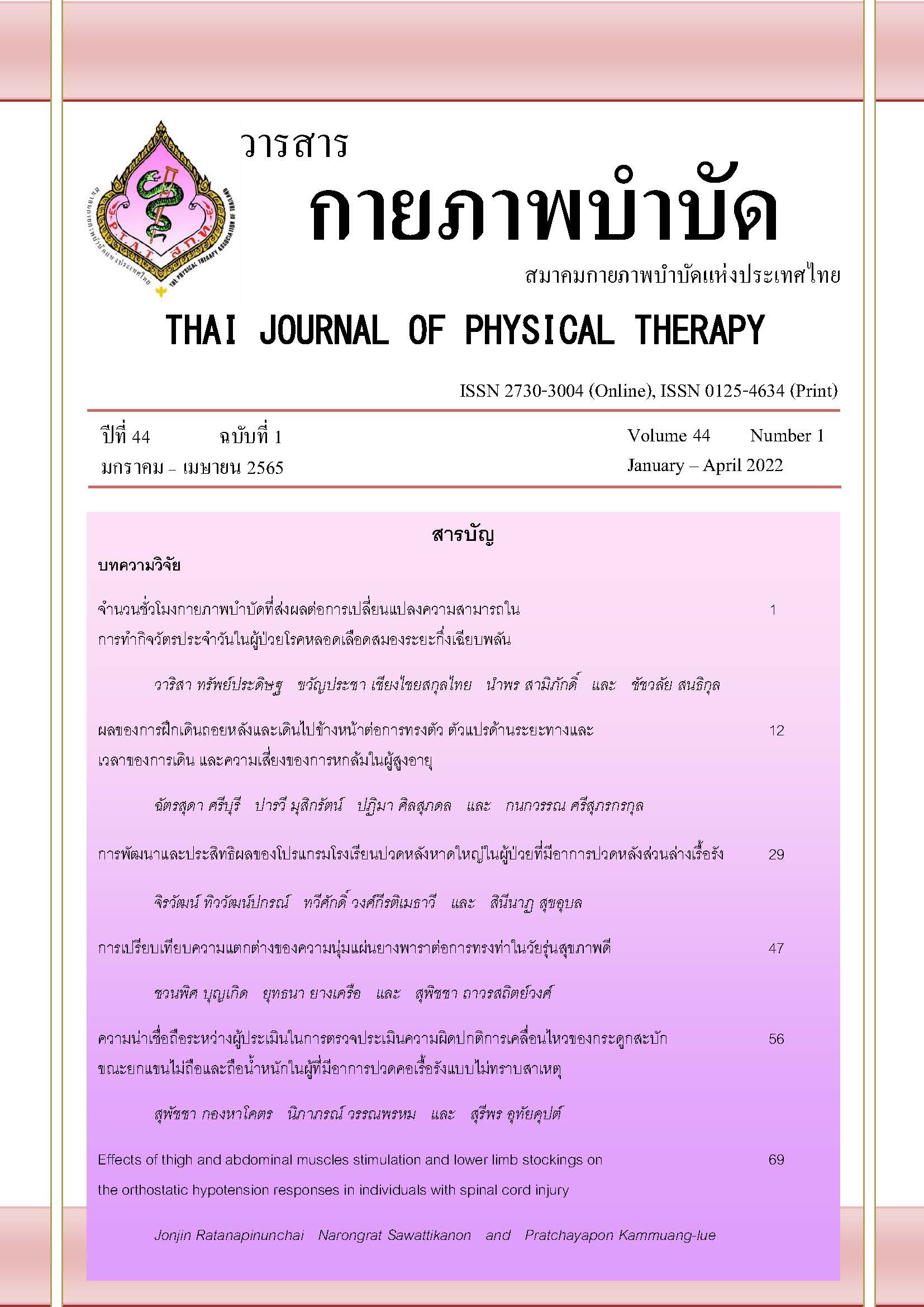ความน่าเชื่อถือระหว่างผู้ประเมินในการตรวจประเมินความผิดปกติการเคลื่อนไหวของกระดูกสะบักขณะยกแขนไม่ถือและถือน้ำหนักในผู้ที่มีอาการปวดคอเรื้อรังแบบไม่ทราบสาเหตุ
Main Article Content
บทคัดย่อ
ที่มาและความสำคัญ: การเปลี่ยนแปลงการเคลื่อนไหวของกระดูกสะบักถูกพบในผู้ที่มีอาการที่มีอาการปวดคอเรื้อรังแบบไม่ทราบสาเหตุ อย่างไรก็ตาม ความน่าเชื่อถือในการตรวจประเมินการเคลื่อนไหวของกระดูกสะบักยังไม่มีการศึกษาในกลุ่มประชากรนี้
วัตถุประสงค์: เพื่อศึกษาความน่าเชื่อถือระหว่างผู้ประเมินในการสังเกตความผิดปกติของการเคลื่อนไหวของกระดูกสะบักขณะยกแขนไม่ถือและถือน้ำหนักในผู้ที่มีอาการปวดคอเรื้อรังแบบไม่ทราบสาเหตุ
วิธีการวิจัย: อาสาสมัครที่มีอาการปวดคอเรื้อรังแบบไม่ทราบสาเหตุจำนวน 50 คน ถูกรวบรวมเข้าร่วมการศึกษา ความผิดปกติของการเคลื่อนไหวของกระดูกสะบักถูกประเมินโดยผู้ประเมิน 2 คนที่อิสระต่อกัน และประเมินในข้างเดียวกับด้านที่มีอาการปวดคอมากที่สุดขณะยกแขนขึ้นถือและไม่ถือตุ้มน้ำหนัก โดยใช้เกณฑ์ “มี/ไม่มี” และ “รูปแบบของการเคลื่อนไหวที่ผิดปกติ” ร้อยละของความสอดคล้องค่าสัมประสิทธิ์โคเฮนแคปปา(k) ค่าสัมประสิทธิ์แคปปาที่ปรับแก้ไขความชุกและความลำเอียง (PABAK) ค่าดัชนีความชุก (PI) และดัชนีความลำเอียง (BI) ถูกนำมาวิเคราะห์เพื่อประเมินความน่าเชื่อถือระหว่างผู้ประเมิน
ผลการวิจัย: จากการใช้เกณฑ์ “มี/ไม่มี” ความน่าเชื่อถือระหว่างผู้ประเมินอยู่ในระดับดีเมื่อทดสอบไม่ถือตุ้มน้ำหนัก (ร้อยละของความสอดคล้อง = 88%, k = 0.69, PABAK = 0.76) และระดับดีมากเมื่อทดสอบถือตุ้มน้ำหนัก (ร้อยละของความสอดคล้อง = 96%, k = 0.86, PABAK = 0.92) จากการใช้เกณฑ์ “รูปแบบของการเคลื่อนไหวที่ผิดปกติ” ความน่าเชื่อถือระหว่างผู้ประเมินอยู่ในระดับปานกลางเมื่อทดสอบไม่ถือตุ้มน้ำหนัก (ร้อยละของความสอดคล้อง = 72%, k = 0.54, PABAK = 0.62) และระดับดีเมื่อทดสอบถือตุ้มน้ำหนัก (ร้อยละของความสอดคล้อง = 88%, k = 0.68, PABAK = 0.73) พบผลของความชุกต่อค่า k (PI อยู่ระหว่าง 0.48-0.64) แต่ไม่พบผลของความลำเอียง (BI อยู่ระหว่าง 0.00-0.08 ตามลำดับ)
สรุปผล: การประเมินความผิดปกติของการเคลื่อนไหวของกระดูกสะบักด้วยการสังเกตเป็นวิธีที่มีความน่าเชื่อถือในการประเมินความผิดปกติของการเคลื่อนไหวของกระดูกสะบักในผู้ที่มีอาการปวดคอเรื้อรังแบบไม่ทราบสาเหตุ
คำสำคัญ: ปวดคอ การเคลื่อนไหวที่ผิดปกติของกระดูกสะบัก การประเมิน ความน่าเชื่อถือระหว่างผู้ประเมิน
Article Details

อนุญาตภายใต้เงื่อนไข Creative Commons Attribution-NonCommercial-NoDerivatives 4.0 International License.
เอกสารอ้างอิง
Kibler WB, Ludewig PM, McClure PW, Michener LA, Bak K, Sciascia AD. Clinical implications of scapular dyskinesis in shoulder injury: The 2013 consensus statement from the 'Scapular Summit'. Br J Sports Med. 2013;47: 877-85.
Hickey D, Solvig V, Cavalheri V, Harrold M, McKenna L. Scapular dyskinesis increases the risk of future shoulder pain by 43% in asymptomatic athletes: a systematic review and meta-analysis. Br J Sports Med. 2018;52: 102-10.
Helgadottir H, Kristjansson E, Mottram S, Karduna A, Jonsson H Jr. Altered alignment of the shoulder girdle and cervical spine in patients with insidious onset neck pain and whiplash-associated disorder. J Appl Biomech. 2011;27:181-91.
Helgadottir H, Kristjansson E, Mottram S, Karduna AR, Jonsson H Jr. Altered scapular orientation during arm elevation in patients with insidious onset neck pain and whiplash-associated disorder. J Orthop Sports Phys Ther. 2010;40:784-91.
Yildiz TI, Cools A, Duzgun I. Alterations in the 3-dimensional scapular orientation in patients with non-specific neck pain. Clin Biomech. 2019;70:97-106.
Zabihhosseinian M, Holmes MW, Howarth S, Ferguson B, Murphy B. Neck muscle fatigue differentially alters scapular and humeral kinematics during humeral elevation in subclinical neck pain participants versus healthy controls. J Electromyogr Kinesiol.2017; 33:73-82.
Paine R, Voight ML. The role of the scapula. Int J Sports Phys Ther. 2013;8:617-29.
Schüldt K, Ekholm J, Harms-Ringdahl K, Németh G, Arborelius UP. Effects of arm support or suspension on neck and shoulder muscle activity during sedentary work. Scand J Rehabil Med. 1987;19:77-84.
Van Dillen LR, McDonnell MK, Susco TM, Sahrmann SA. The immediate effect of passive scapular elevation on symptoms with active neck rotation in patients with neck pain. Clin J Pain. 2007;23:641-7.
Ha SM, Kwon OY, Yi CH, Jeon HS, Lee WH. Effects of passive correction of scapular position on pain, proprioception, and range of motion in neck-pain patients with bilateral scapular downward-rotation syndrome. Man Ther. 2011;16:585-9.
Behrsin JF, Maguire K. Levator scapulae action during shoulder movement: a possible mechanism for shoulder pain of cervical origin. Aust J Physiother. 1986;32:101-6.
Jull G, Sterling M, Falla D, Treleaven J, O'Leary S. Whiplash headache and neck pain: research-based directions for physical therapies. Edinburgh, UK: Elsevier, 2008.
Kibler WB, Uhl TL, Maddux JW, Brooks PV, Zeller B, McMullen J. Qualitative clinical evaluation of scapular dysfunction: a reliability study. J Shoulder Elbow Surg. 2002;11:550-6.
Uhl TL, Kibler WB, Gecewich B, Tripp BL. Evaluation of clinical assessment methods for scapular dyskinesis. Arthroscopy. 2009; 25: 1240-8.
McClure P, Tate AR, Kareha S, Irwin D, Zlupko E. A clinical method for identifying scapular dyskinesis, part 1: reliability. J Athl Train. 2009; 44:160-4.
Forte FC, de Castro MP, de Toledo JM, Ribeiro DC, Loss JF. Scapular kinematics and scapulohumeral rhythm during resisted shoulder abduction--implications for clinical practice. Phys Ther Sport. 2009;10:105-11.
Klopcar N, Lenarcic J. Bilateral and unilateral shoulder girdle kinematics during humeral elevation. Clin Biomech. 2006;21:S20-6.
Timmons MK, Thigpen CA, Seitz AL, Karduna AR, Arnold BL, Michener LA. Scapular kinematics and subacromial-impingement syndrome: a meta-analysis. J Sport Rehabil. 2012;21:354-70.
Bogduk N. Regional musculoskeletal pain. The neck. Baillieres Best Pract Res Clin Rheumatol. 1999;13:261-85.
Guzman J, Hurwitz EL, Carroll LJ, Haldeman S, Côté P, Carragee EJ, et al. A new conceptual model of neck pain: linking onset, course, and care: the bone and joint decade 2000-2010 task force on neck pain and its associated disorders. Spine. 2008;33:S14-23.
Falla D, Bilenkij G, Jull G. Patients with chronic neck pain demonstrate altered patterns of muscle activation during performance of a functional upper limb task. Spine. 2004;29: 1436-40.
Castelein B, Cools A, Parlevliet T, Cagnie B. Are chronic neck pain, scapular dyskinesis and altered scapulothoracic muscle activity interrelated?: a case-control study with surface and fine-wire EMG. J Electromyogr Kinesiol. 2016;31:136-43.
Uthaikhup S, Paungmali A, Pirunsan U. Validation of Thai versions of the neck disability index and neck pain and disability scale in patients with neck pain. Spine. 2011;36:E1415-21.
McHugh ML. Interrater reliability: the kappa statistic. Biochem Med. 2012;22:276-82.
Landis JR, Koch GG. The measurement of observer agreement for categorical data. Biometrics. 1977;33:159-74.
Byrt T, Bishop J, Carlin JB. Bias, prevalence and kappa. J Clin Epidemiol. 1993;46:423-9.
Kopkow C, Lange T, Schmitt J, Kasten P. Interrater reliability of the modified scapular assistance test with and without handheld weights. Man Ther. 2015;20:868-74.
McQuade KJ, Smidt GL. Dynamic scapulohumeral rhythm: the effects of external resistance during elevation of the arm in the scapular plane. J Orthop Sports Phys Ther. 1998;27:125-33.
McQuade KJ, Dawson J, Smidt GL. Scapulothoracic muscle fatigue associated with alterations in scapulohumeral rhythm kinematics during maximum resistive shoulder elevation. J Orthop Sports Phys Ther. 1998;28: 74-80.
Zakharova-Luneva E, Jull G, Johnston V, O'Leary S. Altered trapezius muscle behavior in individuals with neck pain and clinical signs of scapular dysfunction. J Manipulative Physiol Ther. 2012;35:346-53.
Helgadottir H, Kristjansson E, Einarsson E, Karduna A, Jonsson H Jr. Altered activity of the serratus anterior during unilateral arm elevation in patients with cervical disorders. J Electromyogr Kinesiol. 2011;21:947-53.
Falla D, Farina D. Muscle fiber conduction velocity of the upper trapezius muscle during dynamic contraction of the upper limb in patients with chronic neck pain. Pain. 2005; 116:138-45.
Roche SJ, Funk L, Sciascia A, Kibler WB. Scapular dyskinesis: the surgeon's perspective. Shoulder Elbow. 2015;7:289-97.


